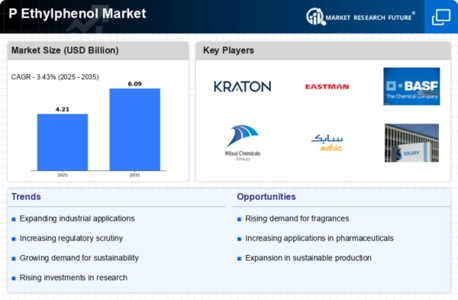Rising Demand in Pharmaceuticals
The P Ethylphenol Market is experiencing a notable increase in demand from the pharmaceutical sector. This compound is utilized as an intermediate in the synthesis of various drugs, particularly in the production of antiseptics and disinfectants. As the global population continues to grow, the need for effective healthcare solutions is paramount. Recent data indicates that the pharmaceutical industry is projected to expand at a compound annual growth rate of approximately 5.5% over the next five years. This growth is likely to drive the demand for P Ethylphenol, as manufacturers seek reliable intermediates to enhance their production processes. Furthermore, the increasing focus on health and hygiene is expected to further bolster the market, as P Ethylphenol plays a crucial role in developing effective medicinal products.
Innovations in Chemical Manufacturing
The P Ethylphenol Market is benefiting from ongoing innovations in chemical manufacturing processes. Advances in production techniques, such as green chemistry and biotechnological methods, are enhancing the efficiency and sustainability of P Ethylphenol production. These innovations not only reduce the environmental impact but also lower production costs, making P Ethylphenol more accessible to various industries. As manufacturers adopt these cutting-edge technologies, the market is likely to see an increase in supply, which could lead to competitive pricing. Furthermore, the emphasis on sustainable practices aligns with the growing consumer preference for environmentally friendly products, potentially expanding the market reach of P Ethylphenol across multiple sectors.
Expansion in Agrochemical Applications
The P Ethylphenol Market is witnessing a surge in applications within the agrochemical sector. This compound is recognized for its effectiveness as a pesticide and herbicide, contributing to improved agricultural productivity. With the global population projected to reach 9.7 billion by 2050, the demand for food is anticipated to rise significantly. Consequently, agrochemical manufacturers are increasingly incorporating P Ethylphenol into their formulations to enhance crop yields and protect against pests. Recent statistics suggest that the agrochemical market is expected to grow at a rate of 4.2% annually, which may lead to a corresponding increase in the demand for P Ethylphenol as a key ingredient in sustainable agricultural practices.
Growth in Personal Care and Cosmetics Sector
The P Ethylphenol Market is experiencing growth driven by the expanding personal care and cosmetics sector. This compound is increasingly utilized in the formulation of various cosmetic products due to its antimicrobial properties. As consumers become more conscious of product safety and efficacy, the demand for high-quality personal care items is on the rise. Recent market analysis suggests that the global cosmetics industry is projected to grow at a rate of 4.5% annually, which may lead to increased utilization of P Ethylphenol in cosmetic formulations. This trend indicates a potential for market expansion, as manufacturers seek to incorporate effective and safe ingredients to meet consumer expectations in the personal care domain.
Increasing Regulatory Support for Chemical Safety
The P Ethylphenol Market is influenced by the increasing regulatory support for chemical safety and environmental protection. Governments worldwide are implementing stricter regulations regarding the use of chemicals in various applications, including pharmaceuticals and agrochemicals. This regulatory landscape is prompting manufacturers to seek safer and more effective alternatives, positioning P Ethylphenol as a viable option due to its favorable safety profile. Recent legislative measures indicate a trend towards promoting chemicals that meet stringent safety standards, which may enhance the market appeal of P Ethylphenol. As companies strive to comply with these regulations, the demand for compliant and safe chemical intermediates is expected to rise, further driving the growth of the P Ethylphenol Market.



.webp)
.webp)
.webp)
.webp)
.webp)
.webp)








Leave a Comment